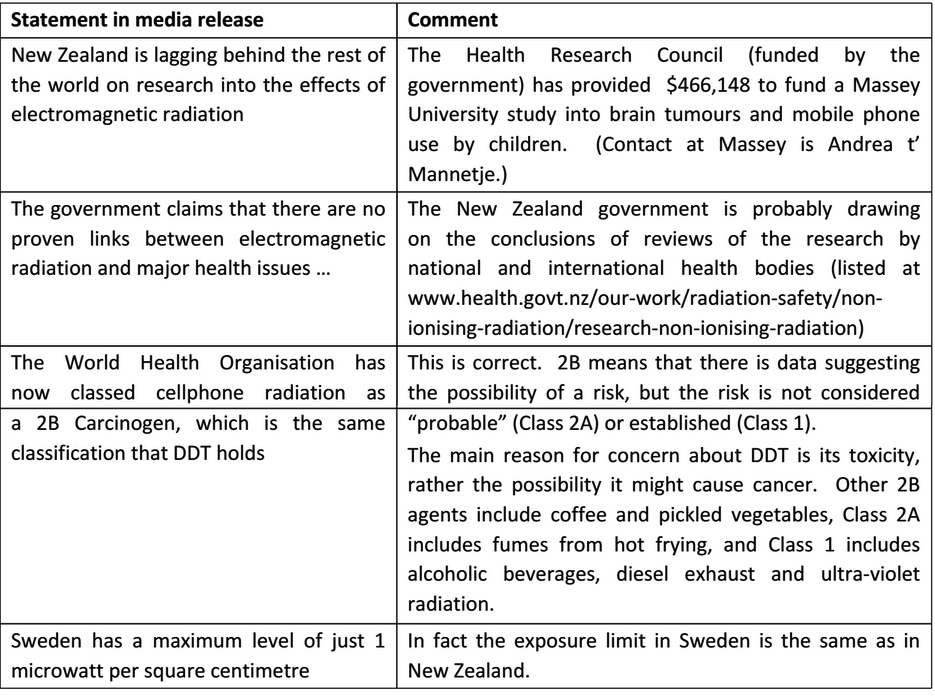A New Zealand-based lobby group Safer Wireless Technology New Zealand Incorporated (also known as Ban the Tower) is urging the Government to conduct further research into the potential health impacts of using WiFi and related wireless technology devices.
 The group, represented by retired cardiologist Dr Stuart Reuben, claims that exposure to electro-magnetic fields at levels currently allowed in New Zealand could cause brain cancers.
The group, represented by retired cardiologist Dr Stuart Reuben, claims that exposure to electro-magnetic fields at levels currently allowed in New Zealand could cause brain cancers.
In a press release, Dr Reuben comments:
“…if we continue to allow our children to be exposed to high levels of electromagnetic radiation, many of them are very likely to be diagnosed with leukemia and brain tumours within a few years”.
The group cite a paper published in the International Journal of Oncology, which looks at the use of wireless phones such as cellphones and cordless phones, and the risk of malignant and non-malignant brain tumours among users of these devices. The researchers concluded:
“This study confirmed previous results of an association between mobile and cordless phone use and malignant brain tumours. These findings provide support for the hypothesis that RF-EMFs play a role both in the initiation and promotion stages of carcinogenesis.”
The paper did not look at WiFi devices, which SWTNZ has called for more research into the safety of.
The SMC gathered commentary from experts on electromagnetic radiation and biostatistics. Further comments will be added to the SMC website.
Martin Gledhill, former senior advisor at the National Radiation Laboratory, New Zealand’s representative to the World Health Organization’s EMF Project and a consultant on electromagnetic fields comments:
There are three questions to be addressed here:
1) Are exposures to mobile phones/cordless phones (the subject of the research in the paper cited) relevant when considering exposures from WiFi (which SWTNZ are warning about)?
While the transmitting power of a mobile phone/cordless phone is broadly similar to that of a WiFi access point and the WiFi transmitter in a laptop or other mobile device, exposures from a mobile phone are much higher because it is held next to the head.
2) Are findings on brain tumours in relation to mobile phones/cordless phones relevant to SWTNZ’s claims about effects on headaches and nausea?
There has been a lot of research published investigating whether exposures to radio frequency fields from mobile phones and other types of transmitter causes symptoms such as headaches and nausea. This has included studies of people who consider themselves to be unusually sensitive to such exposures. There have been both laboratory studies, and studies carried out in people’s homes.
Recent reviews of this work¹ conclude that these symptoms are not related to exposures to RF fields, but that there may be some “nocebo” effect (ie people are more likely to experience symptoms if they believe they are being exposed).
3) How does the research in the paper cited sit in the context of other research on the same subject?
The reference cited in the media release analyses studies of acoustic neuroma (a type of brain tumour) in relation to wireless phone use by a Swedish group led by L. Hardell. Other researchers have studied both acoustic neuromas and other types of brain tumour in relation to wireless phone use. The Hardell group has also studies other types of brain tumour.
Several analyses which pool the results from all study groups have been published. While these do not include the latest data from the Hardell group, this probably does not have a large effect as Hardell’s latest paper only adds 73 cases to the 243 covered in a previous publication. The most recent pooled analysis² concluded that:
“Overall, a causal association between mobile phone use and incidence of glioma, meningioma or acoustic neuroma is not supported by the current study [ie the Lagorio pooled analysis]”.
They also noted inconsistencies between studies, due largely to the Hardell findings, and that laboratory work does not support an effect of wireless phone use on cancer development. The Health Council of the Netherlands concluded³:
“The Committee feels that the data on an association between long term use of a mobile phone and acoustic neuroma are inconsistent and do not really give an indication for an increased risk.”
It is perhaps also worth noting that while the Hardell group generally finds greater risks of brain tumours associated with mobile phone use than other researchers, their conclusions are not consistent with data on brain tumour incidence(4).
In summary, then, it would be unwise to take the Hardell findings in isolation: they should be evaluated in the context of similar research, which is generally interpreted as providing no clear indication of an increased risk of brain tumours for periods of wireless phone use up to about 14 years. On the other hand, because of the possibility of long latency periods (the time between the exposure and the development of a tumour), health bodies recommend continuing research in this area.
In addition, I have some other comments on the SWTNZ media release.
1. See, for example, reviews by the UK Health Protection Agency (now Public Health England), the Swedish Radiation Safety Authority at , and the Norwegian Institute of Public Health.
2. Lagorio et al. Mobile phone use and risk of intracranial tumors: a consistency analysis, Bioelectromagnetics (2013), DOI 10.1002/bem.21829
3. www.gezondheidsraad.nl/en/publications/environmental-health/mobile-phones-and-cancer-part-1-epidemiology-tumours-head
4. Little et al. Mobile phone use and glioma risk: comparison of epidemiological study results with incidence trends in the United States. BMJ 2012;344:e1147 doi: 10.1136/bmj.e1147
Thomas Lumley, Professor of Biostatistics, University of Auckland comments:
“The International Journal of Oncology paper is of higher quality than most research suggesting health risks of radio eaves, but does not provide any real support for concerns about WiFi.
“Firstly, the claims in the TVNZ story about “brain cancer” in general are entirely unsupported; the research was on one specific, rare, usually treatable type of benign brain tumour. There is fairly convincing evidence that brain cancer in general is not caused by cellphones. The US National Cancer Institute has a good summary of the evidence.
“Second, even if the associations reported in the paper are real and causal, they do not suggest a risk from WiFi. The researchers report a higher risk of acoustic neuroma in the ear used for phone conversation than in the other ear, suggesting that proximity to the transmitter is important. People do not usually press their heads up against WiFi transmitters — even with cellphones, WiFi is more likely to be used when you are looking at the screen.”
Read further commentary from Professor Lumley is published on StatsChat.
